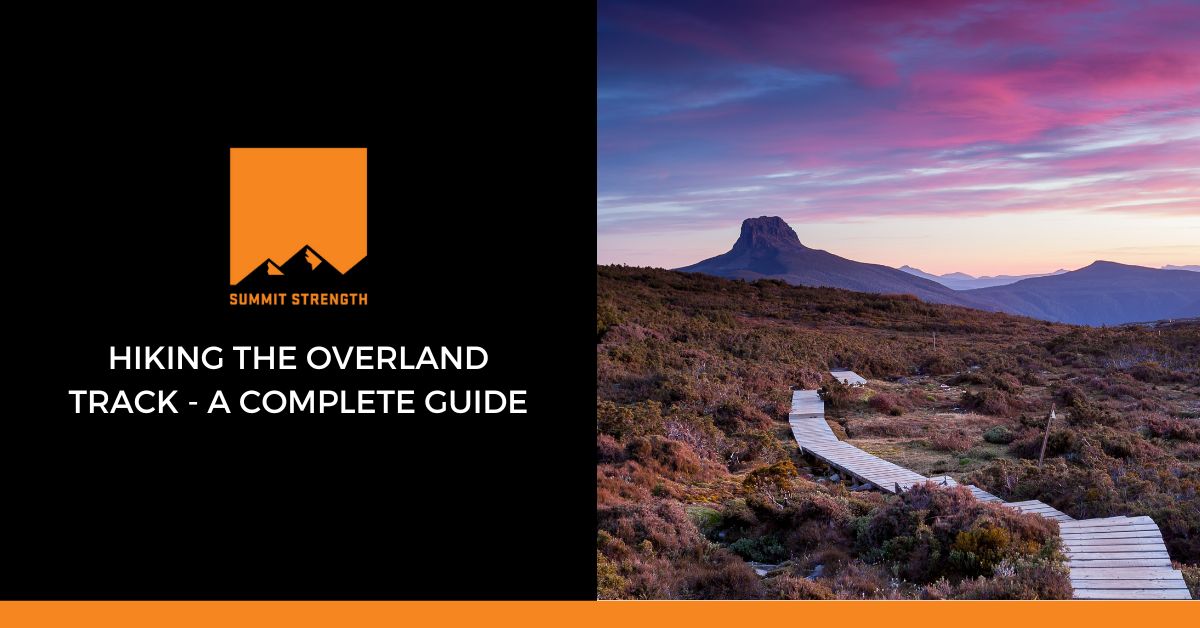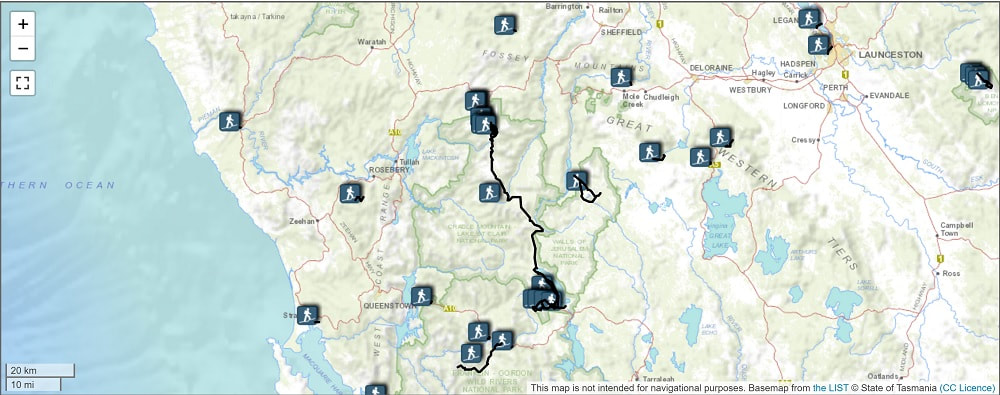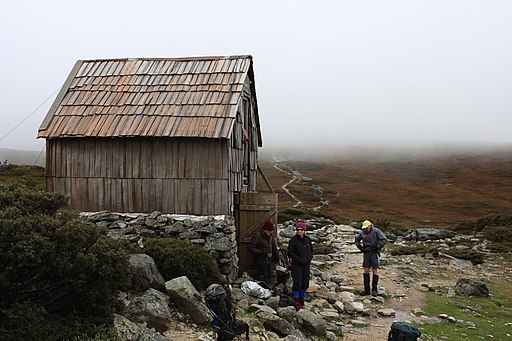|
Many keen hikers in Australia dream of traversing the Overland Track in Tasmania. It's one of the most famous passes in the world, running through rugged Tasmanian territory in the Cradle Mountain-Lake St Clair National Park and offering challenges for even the most experienced bushwalkers. Furthermore, it connects to various side trips you can take to extend your adventure and probe deeper into the wilderness. This article aims to provide you with a comprehensive guide on how to train for and hike The Overland Track answering questions we get asked often by hikers who have it on their agenda. Let's dig in. What is the Overland Track? The Overland Track is a 65-kilometre trail that runs through the heart of Tasmania's wilderness. It starts at Cradle Mountain, ends at Lake St Clair, and usually takes six to eight days to complete. The track passes through various terrains, including alpine plateaus, ancient rainforests, and crystal-clear lakes. Along the way, hikers can expect to see a range of wildlife, including possums, wallabies, and Tasmanian devils. The trail can be challenging, with steep ascents and descents, but it rewards trekkers with stunning views and unforgettable experiences. You must be self-sufficient and carry all your supplies, including food and appropriate clothing, as there are no shops or facilities along the way. The Overland Track is one of Australia's most iconic hikes and a must-do for anyone interested in exploring Tasmania's natural beauty. Is the Overland Track hard? The Overland Track itself is manageable for semi-experienced hikers. Averagely fit people should be able to complete it over several days. However, there are factors, both external and internal, that could make the trek a lot more challenging. First of all, weather conditions can affect the difficulty of the track. The trail can be covered in snow in winter, making it even more challenging. In summer, hikers can face extreme heat, sun exposure, and the possibility of rain and storms. That being said, the Overland Track is a well-marked and well-managed trail, and there are huts and campsites along the way where hikers can rest and recharge. With proper preparation, training, and equipment, most people with a reasonable fitness level can complete the Overland Track. You must walk around 12 km daily with approximately 18kg on your back to succeed. Note that some track sections are slippery and hazardous. You can make the trip easier by choosing lightweight, portable gear. Going as lightweight as possible makes the numerous climbs and descents less taxing. What equipment will I need? The Overland Track is a popular hiking route. It can be straightforward to complete with the proper training and equipment. Most trips include rain, wind, snow, or a combination of all three, making preparation essential. Cradley Valley will see some form of precipitation almost half the year, so chances are you'll get some of that on the trail. Aiming to pack as light as possible will help with the hike, but you still want to ensure you have everything you need. You'll also need to carry all your food supplies and clothing for all kinds of weather, regardless of which part of the year you're going. Let's look at the essential kit you might want to consider:
What month is best for Overland Track?Because Tasmania is so far South, summers tend to be mild, not hot. Therefore, the most popular months for hiking the Overland Track are December, January and February. Average maximums are just 16°C, the perfect temperature for hiking with a heavy backpack. However, a word of warning: Tasmanian summers can sometimes get extremely hot, more than 30°C. It all depends on the particular days you choose. Moreover, mild conditions can end abruptly because the season is short. Autumn brings much cooler temperatures without warning. From March to May, hikers can expect cooler temperatures. Still, the trail is less crowded, and the autumn foliage can be spectacular. The track can experience snow and icy conditions in late May, making it more challenging and dangerous for inexperienced hikers. It's important to note that weather conditions in Tasmania can be unpredictable, and hikers should be prepared for sudden changes in temperature, rain, or storms, regardless of the time of year. How long does it take to hike the Overland Track? Most people complete the Overland Track in around six days. However, your itinerary is entirely up to you. You can take one or more rest days to take it easy between hiking days. Many serious hikers take side trips to extend the length of their adventure. Popular options include:
You can also attempt completing the trail in a single day. However, you will need to run most of it. Only experienced ultra-marathon runners have a good chance of succeeding. How much does it cost to hike the Overland Track? The cost of hiking the Overland Track varies depending on several factors, including whether you are trekking independently or with a guided tour, the time of year, and the length of your hike. If you are hiking independently, the fees are as follows (as of April 2023):
Park officials recommend against taking children under eight because of the trail's difficulty. You must register in advance on the Tasmania Parks and Wildlife Service website to book a spot. Bookings are available for the summer period from 1 October until 31 May (though this may change in future years). You will also need a valid park pass to enter any of Tasmania's national parks. The cost of a pass depends on where you want to visit and how long you want to stay. Again, you can find more information on the Tasmania Parks and Wildlife Service website. If you choose to take a guided tour, the cost will depend on the tour company and the length of the hike. A 6-day guided trek can range from $2500 to $4000 per person. How fit do you need to be to walk the Overland Track? Walking the Overland Track requires a moderate to high fitness level. The trail involves traversing steep and rocky terrain, crossing streams, and hiking for several hours daily. You should have experience with multi-day hikes and be comfortable carrying a backpack weighing around 15-20kg. You should be able to maintain a reasonable pace, walk for 6-8 hours a day, and be able to hike uphill for extended periods. I recommend undertaking a fitness program before embarking on the Overland Track, such as regular aerobic exercise, strength training, and practice walks and hikes with a weighted backpack to improve your fitness level, endurance and strength. It's also essential to be adequately prepared for the weather conditions, as the weather is unpredictable in the region. Being physically and mentally prepared is critical for a safe and enjoyable journey on the Overland track. Are there toilets on the Overland Track? Yes, there are toilets at each hut along the Overland Track and other designated campsites along the trail. However, you may need to hike several miles before reaching one, so be prepared to seek other options when it's urgent. It is also important to note that these toilets are basic composting or pit toilets. Be ready to bring your own toilet paper and hand sanitiser. Can you do the Overland Track without booking? No, doing the Overland Track without booking in advance is impossible. The Overland Track is a popular and highly regulated hut-to-hut hiking trail requiring hikers to obtain a permit through the Tasmanian Parks and Wildlife Service. You cannot walk the Overland Track between October and May without booking. Authorities limit the supply of permits to protect the landscape. There are fewer than 60 permits per day during the summer months. This is to ensure that there is enough accommodation available for hikers and to manage the impact of hiking on the fragile alpine environment. It is essential to book in advance to avoid disappointment, as the number of hikers on the trail is limited, and the track is closed during the winter months. Therefore, we recommend booking as early as you can. The Tasmania Parks and Wildlife Service announces in advance when permits become available. Can you walk Overland Track for free? Unfortunately, you cannot walk the Overland Track for free. During the summer season, you'll have to pay a $200 fee for the permit, which covers the cost of maintaining the huts, tracks, and facilities along the trail and providing essential safety information and emergency services. The cheapest way to do it is in winter, when you don't need a permit, from June 1 to September 31. If you go at this time of the year, you do not need to book a permit to hike the trail, but you still need to purchase a park pass from the Tasmanian authorities and then battle snow and cold weather. Can you hike the Overland Track Solo? The Tasmania Parks and Wildlife Service issues 34 permits daily for independent walkers. Solo hiking on the Overland Track is permitted. Still, it is strongly recommended that hikers travel with a companion or join a guided tour. The track is a challenging and remote wilderness experience, and there are risks and hazards associated with hiking in this environment. Hiking with a companion or a group provides additional safety and support and the opportunity to share the experience with others. It is important to note that if hiking solo, hikers should be experienced and well-prepared, with appropriate gear, skills, and knowledge of the area. They should also take extra precautions, such as carrying a Personal Locator Beacon (PLB) and informing others of their itinerary and expected return date. Most people hire a guide to help them complete the Overland Track in the recommended six days. These arrangements reduce the risk of getting lost and ensure you are fully prepared in case you forget to bring something with you. They also take you via the most scenic routes and side trips, helping you experience more of the landscape. Can you camp anywhere on the Overland Track? No, camping is only permitted in designated campsites along the Overland Track. These campsites are clearly marked and are located at strategic points along the trail, such as near huts, water sources, and other facilities. Camping outside these designated campsites is not permitted, as it can cause damage to the fragile alpine environment and disrupt the natural ecosystem. It is important to note that the number of hikers on the trail is limited, and campsites can fill up quickly during peak season. It is essential to book and pay for camping permits in advance to avoid disappointment and ensure sufficient space is available. In addition, you must follow leave-no-trace rules. ConclusionHiking the Overland Track is an extraordinary outdoor adventure that takes you through some of Tasmania's most beautiful and rugged wilderness areas. This complete guide has all the essential information to plan and prepare for your Overland Track journey. From the best time to hike, permits and fees, gear and equipment, to safety tips, this guide has covered everything you need to know to get started.
Remember, the Overland Track is a challenging and remote hiking trail. Preparation and appropriate training are critical to ensuring a safe and enjoyable experience. Whether you prefer to hike solo or join a guided tour, the Overland Track will provide an unforgettable adventure that will leave you with memories to last a lifetime. Feel free to check out our podcast episode on How to Train for the Overland Track, where I speak to Andrea about her experience so you can hear first-hand what it's like and how to prepare. Then I'll talk about the best way to approach your cardio and strength training so your journey will feel like a breeze. If you have questions or want personalised advice for your training plan, don't hesitate to get in touch! Comments are closed.
|
AuthorRowan is a personal trainer who specialises in training for hiking, trekkers and mountaineers for their bucket list adventures. Archives
July 2024
Categories
All
|
AboutSummit Strength is a personal training for hiking service created specifically to help hikers have the best chance of a safe, enjoyable and successful adventure.
|
Company |
Services |
|
|
© COPYRIGHT 2018. ALL RIGHTS RESERVED.
|
Website Design by My Personal Trainer Website
|




 RSS Feed
RSS Feed
